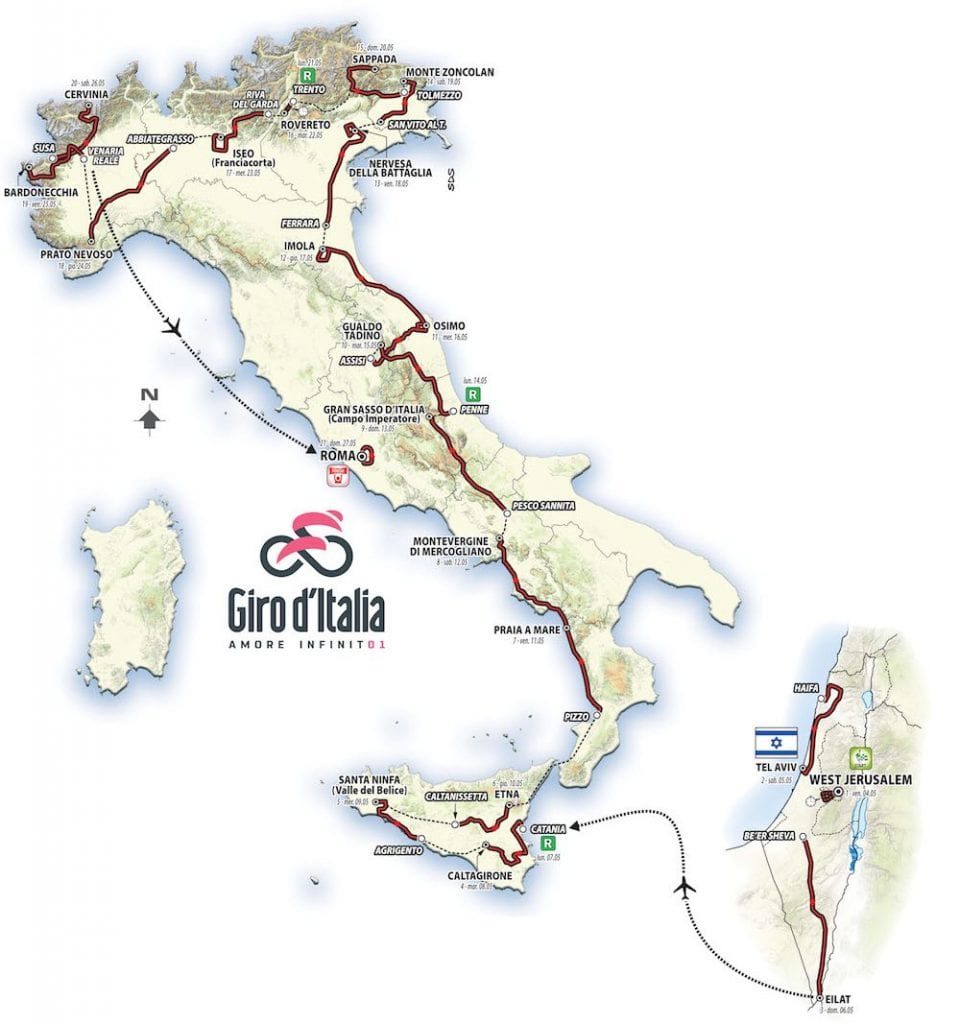 The 101st edition of the Giro d'Italia appears to be a tough, testing but a classic-looking race. There are few innovations after the historic start in Israel but the mountainous route should ensure the Giro keeps its self-styled moniker of 'the toughest race in the world’s most beautiful place'.
The 101st edition of the Giro d'Italia appears to be a tough, testing but a classic-looking race. There are few innovations after the historic start in Israel but the mountainous route should ensure the Giro keeps its self-styled moniker of 'the toughest race in the world’s most beautiful place'.
As previously announced, the race will start with three stages in Israel. The opening 9.7km time trial in Jerusalem on Friday, May 4 will shape the overall classification and perhaps even see Froome immediately in the pink jersey. It is followed by stages for the sprinters to Tel Aviv and Eilat on the edge of the Dead Sea, with time bonuses giving some of them a shot of taking the pink jersey.
Following the Grand Partenza in Israel, the race will transfer to Italy on an early extra rest day on Monday, May 7.
Sicily hosts the Giro d'Italia as it returns home, with two stages into the hilly centre of the island to Caltagirone and Santa Ninfa before an early mountain finish on the slopes of Mount Etna, climbing up to the 1,736-metre-high finish via a new road from the south via Ragalina. The 14.1km climb includes a four-kilometre section at eight per cent and so could cause problems.
After crossing the Straight of Messina by boat, the Giro d'Italia heads north via Calabria and Campania, with another mountain finish to Montevergine do Mercogliano on stage 8. The second weekend ends with the climb up to Campo Imperatore in the shadows of the mighty Gran Sasso, 19 years after Marco Pantani won there.
The central Apennines and heavy rolling country roads often throw up a few surprises and Froome would be wise to recon the four central stages that also include finishes in Gualdo Tadino and Osimo after the Monday rest day. The finish in the hilltop village of Osimo is near the home of the Michele Scarponi and comes after a steep climb like those often seen in Tirreno-Adriatico in the spring.
Two flat stages up the Adriatic coast and across the Po delta take the Giro d'Italia north to Nervese della Battalgia via Imola and Ferrara. Both include short climbs in the finale to make the sprinters suffer for a shot at success. The finish remembers the victims of World War I and is the last chance to recover for the overall contenders before the decisive final week.
The high mountains begin with the 181km 14th stage to Monte Zoncolan in Italy's northeast. It includes four short but steep climbs before the final haul up double-digit gradient of the Zoncolan from Ovaro. The middle five kilometres rise at an average of 14.9 per cent, tough to handle even for the pure climbers.
Stage 15 to Sappada visits the Veneto Dolomites, climbs the Passo Tre Croci and has the steep and little-known Passo di Sant'Antonio and Costalissoio climbs in the finale. It seems perfect for a breakaway as the overall contenders begin to focus on the key time trial after the final rest day.
The 34.5km cronometro between Trento and Rovereto follows the valley roads and so will allow Froome to perhaps gain a chunk of time on many of his rivals. Without this stage he surely wouldn't have decided to ride the 2018 Giro d'Italia. It will be up the other riders to take the race to the Briton in the mountains.
Stage 17 is the wine stage of the 2018 Giro d'Italia with a finish in Iseo in the heart of the Franciacorta sparkling wine region, where Froome lived while at Barloworld. It is a rare chance for the sprinters left in the race.
Stage 17 and 18 take the rider east to the Alps with the finish up to Prato Nevoso (13.9km at 7 per cent) the first of the three final mountain stages. Pavel Tonkov and Stefano Garzelli won here in 1996 and 2000, while Simon Gerrans won a stage of the 2008 Tour de France in the ski resort during a rare visit of the Tour into Italy. The sudden transition from flat valley roads to a serious climb up the finish could cause some riders problems and suit others. This year, Dumoulin gained 43 seconds on Nibali on a similar finish to Oropa and took the maglia rosa.
Stage 19 is arguably the hardest stage of the 2018 Giro d'Italia. The 181km include four major climbs with the dirt-road Colle delle Finestre also the Cima Coppi – the highest climb of the race. The fire track twists and turns up the side of the mountain at a constant gradient of 9.2 per cent. It is followed by the gentler road to Sestriere and then the 7.2km Jafferau climb from Bardonecchia. Mauro Santambrogio won here in 2013 before later being caught for doping, with Nibali taking second and going on to win the 2013 Giro d'Italia.
The mountain stages end on the final Saturday, with the 214km haul to Cervinia. The stage includes the 16km Col Tsecure and the 16km Col de Saint-Pantaleon. Both twist up the mountainside and both include steep sections at altitude near the summit.
Aru won in Cervinia in 2015 as he deposed Mikel Landa as Astana team leader that year. We could see the two clash again next year on the 19km climb that will confirm the overall winner of the race.
After the flight from Israel to Sicily transfers between stages during the three weeks of racing are limited. However, the riders face a final flight to Rome on Sunday morning for the final 118km parade stage around the capital. The 10 laps of an 11km circuit do not visit the Vatican but will showcase the beauty of ancient Rome by looping around the Coliseum and finishing on the Via dei Fori Imperiali.
The 2009 Giro d'Italia finished in the same spot, with Russia's Denis Menchov winning overall despite a high-speed crash on the cobbled roads of the capital. The 2018 finish will be more of a celebration stage and a final chance for any sprinters still in the race. It could see Froome win his first-ever Giro d'Italia, complete his Grand Tour hat trick and set up his Giro-Tour double.
